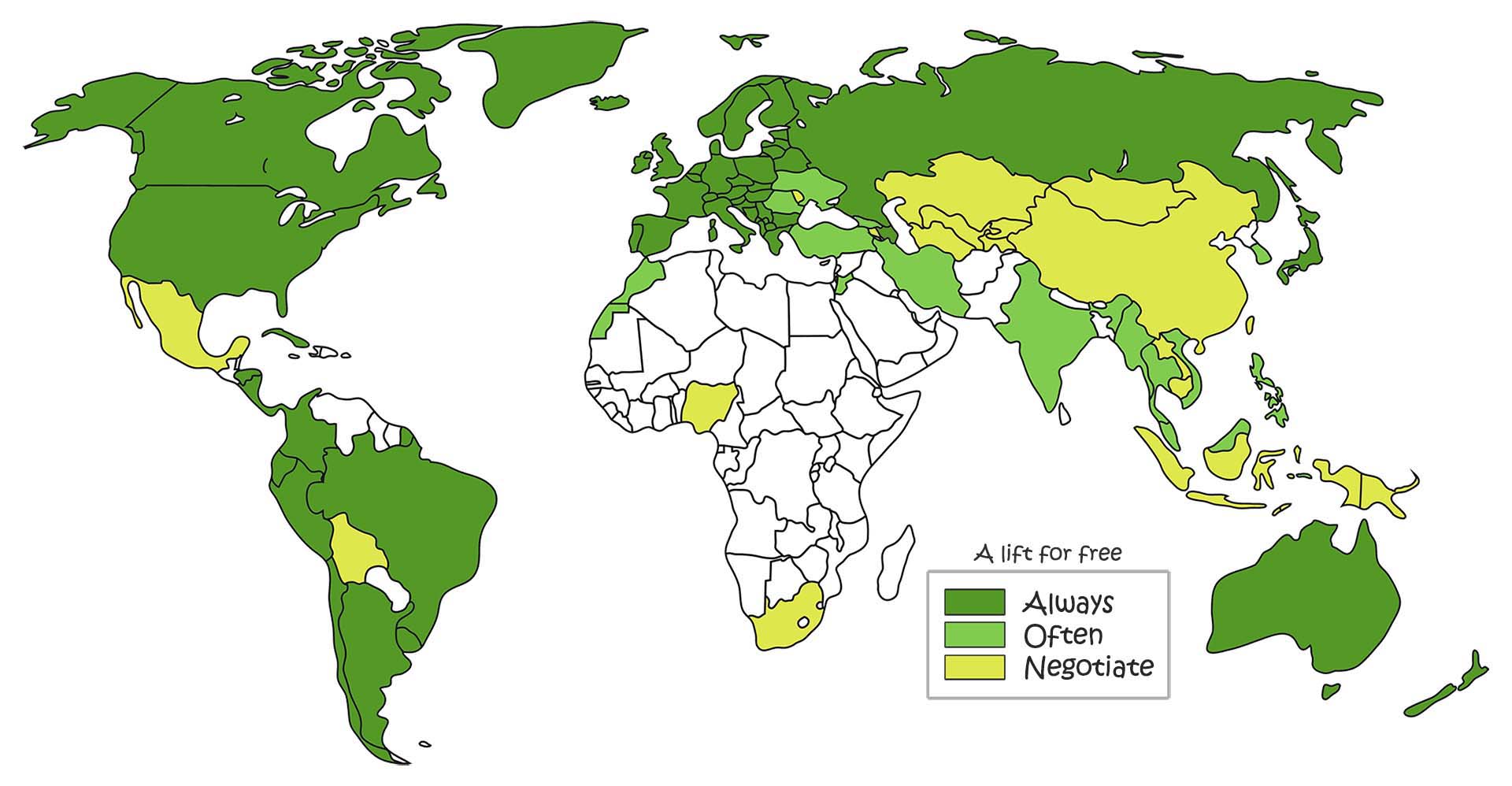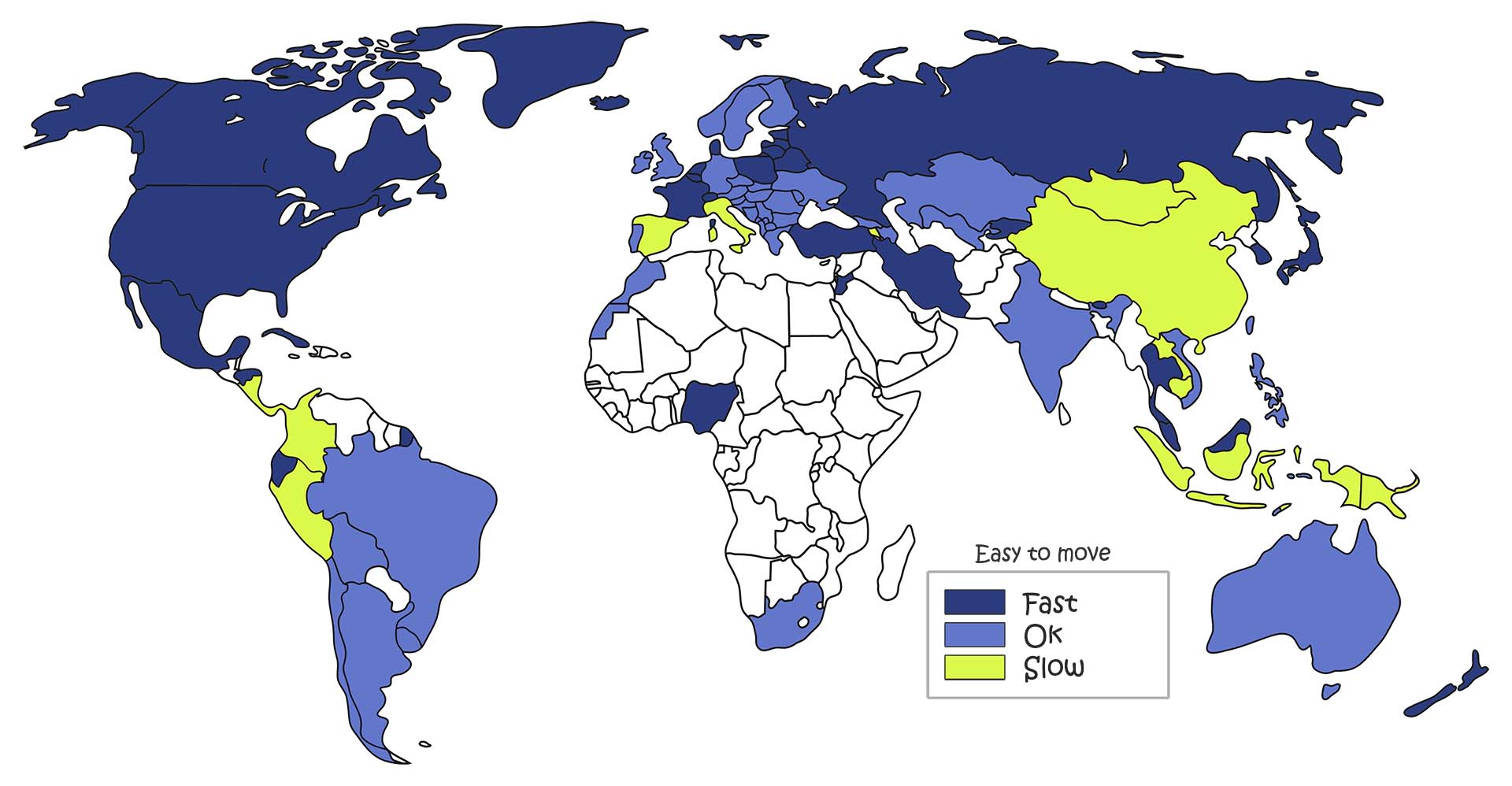You will find many other websites giving some advice about hitchhiking: here is the minimum to know. You can also have a look at:
1 - Travelling for free

- In Western Europe, hitchhiking is free and there is no confusion.
- But in many areas in the World, every car can be a taxi or the customs are to share the price of the gas. It’s the case in Central Asia and (less and less) in Eastern Europe. There you should always ask if it’s for free before getting in the car, if you don’t plan to pay anything. Otherwise you should agree on a price beforehand and be aware of the local prices.
- Finally, and especially in Asia, hitchhiking in not well known. You have to be able to explain simply and clearly what you are doing and what you need. Many people I met didn’t understand the idea of going somewhere with several lifts and without paying. Even if they do half the way they will tell you “no, I can’t” thinking you want to go to your destination in one lift. About going for free, many will insist to take you to an ATM, a station, or even pay the trip for you. Keep in mind that in some cultures, it is expected to negotiate 10 minutes and refuse 10 times before the refusal is agreed. So someone may insist to give you money far beyond your own social norms even if is not really eager to do so, out of politeness. Make sure you don’t deceive people out of cultural differences, I probably did it a few times and I don’t like these memories…
Sometimes, taxi and bus propose to take you for free to your destination. As far as I’m concerned I refuse if I’m not in a difficult situation and I always make sure I don’t take the place of someone paying. If the minibus is full, no one else can get in, it’s time to go out and try another lift. Think also about the problems they can have with their employers.
2 - Communication
It is out of question to abuse people you meet, or to put yourself in danger. So you should be able to communicate with locals, which should be easy if you really care about them.
- The words: free – step – trip – hello – thanks – goodbye – stop, are practical enough
- A sentence like: “I want to go to XXX, can you please help me for free to go further in this direction?” is probably more efficient if it’s simple and corrected by a local. Write it on a paper or on your phone, and learn the pronunciation.
- People will often propose to show you an ATM, or take you to a station. Learn how to say: “I can pay food but I try to use transportation for free. It is a long trip, taxi, bus and train are too expensive” and “I don’t need money”. This can be easily explained with key words and body language.
- Then (or maybe first since this is far more interesting) you can learn some words for the conversation in the car: family – children – work – studies. Mix that with some English words and gestures and you will be impressed by what you can share.
In Europe a low level in English is enough: just be polite. However, try to do some efforts and learn more local words to have richer exchanges.
Some drivers will never stop chatting, some will just want to talk once in a while, when others remain completely silent. They try to help, it’s up to you to adapt : you need to understand how they want to enjoy this moment together, and remain quiet too is they prefer it this way. For sure, you cannot know the personnality of your driver without starting to chat. If they want to talk, try to share some stories or listen carefully what they want to say. It’s also something you can give in exchange of their help.
Note: you can use Google translation on your phone, there is an option to download languages and translate offline
3 - How to stop a car

If you can communicate clearly what you need, everything will be fine as long as there are cars stopping by. Here is a map showing the countries where you may have some issues.
Where should I hitchhike ?
Anywhere as long as there are cars.
In the law and especially in Europe, it is forbidden to hitchhike on the highway, after the toll or in any place where police thinks you’re somehow creating danger. In reality everything can happen whether you want it or not, you have to get ready.
Here are some advice about hitchhiking along a road. But with some motivation you can also talk to people in a gas station, on the street or in any rest area : proactivity will make your trip completely different.
Perfect situation
- The traffic is fluid
- The road goes directly where you want to go – no huge intersection a few kilometers away
- High visibility – for you and the cars in both ways, to avoid collisions
- Free place on the roadside – for you and the stopping car
- A road without slope – epecially for trucks to stop
Other situations and solutions
The traffic is crazy and there is no place to stop: check if there is an intersection or traffic lights in the distance or on the map. The traffic might reduce or be regulated, and the drivers may stop for you.
Too many intersections: The drivers can be confused about where you go if there are too many directions. As long as they stop it’s alright, just be patient and keep asking. If nobody stops try to reach the next intersection on foot or with a short lift, showing the driver where to go on the map. If it’s a highway with many successive intersections it can be useful to reach a rest area or a gas station between two of them. Finally, you can use a sign to write your destination.
Not enough traffic: Walk until the next intersection to have more. Do a lot of signs and step on the road whenever a car comes. Try to go backward to use another road, otherwise you take the risk to be blocked. And if someone finally stops, be sure he goes to a village after which the traffic should be more important.
No traffic at all: It’s not supposed to happen: you should have prepared with water and food. Check if there are villages and markets on the way to get fresh supplies. You can walk 30 to 45 kilometers a day depending on your bag, the slopes and your aptitudes.
Fast traffic on the highway: sometimes people drop you in the wrong place, sometimes it’s the only solution to move on. Stay visible, safely on the roadside or at the end of a slip road. Be sure there is enough place behind you for a car to stop. Drop your bag on the ground, visible but away from the road: you should be able to move fast anytime.
No visibility: in mountainous areas or in some specific cases drivers see you at the last moment. Check your map to find straight lines or longer curves. Place yourself in the best position so cars coming from both directions can see you. They should be able to slow down if a car stops besides you.
A sloppy road: wait or move. On the map, check the long and straight roads or intersections, it has more probability to be flat. Most of the cars would still stop, but it’s an important psychological obstacle. If there are mainly trucks passing by, just hope they are not loaded.
Your appearance:
- Try to wear colourful or light clothes. Use pants instead of shorts, to avoid sunburn and possible sexual harrassment. Shoes are better than flip-flop and if your skin is sensitive wear long sleeves and wear something around your neck.
- Show your bag: it’s an important sign, you’re a great traveller.
- Don’t smoke, especially in Europe and countries where “smoking kills”. Elsewhere, it’s almost an advantage.
- Smile with your lips (with teeth you get cramps…).
- Wearing sunglasses doesn’t help but it’s better to protect yourself. Sometimes a hat is not enough.
- Greasy hair, beard and stained clothes: it’s better without but most drivers won’t see it before stopping and they probably don’t care.
- Finally just think as a driver: he wants you to be clean, respectful and nice, and therefore it should be visible.
The sign:
- Thumb up. In some countries it’s impolite or unknown: I still do it and I explain it to those who stop. It’s a sign we can clearly identify to a free means of transportation, and making it universal can help future travellers. The position: keep your arm horizontal and block your shoulder articulation backward. It’s more visible and you’ll suffer less.
- Else you can just move your hand down as if you ask for a taxi: it’s international. If you are two, you can do both signs simultaneously.
- Finally, in some cases you can do wide signs in the direction you take, to show you do a long distance. It’s really useful to stop trucks.
- Another sign really important: follow the eyes of the drivers to create a first contact.
- Quite often they do signs themselves: try to learn what it means depending on the country. Usually it’s because they are full or they simply don’t want to take you with them. It can be to show their surprise, to ask you what you want, to tell you they turn left, they stay around, they go back, or that there is an intersection a few kilometers away…
The written sign:
Use it only in city areas, on highways with many intersections, or if locals don’t understand any other sign. Else it’s a waste of time and you take the risk to miss some opportunities.
Example: some people don’t go to the city you mention and might not stop, even if it would help you. One of them could invite you to his house on the way, you could discover a beautiful area, or something unexpected.
If you use a written sign you create a rule: I go there. Is it necessary?
Note: you can use Organic Maps (open source equivalent of Maps.me, to find your way offline, just download the maps of the countries you cross. You can also add some signs where you sleep or for the places you want to visit
4 - The dangers
Dangers are real, but mostly overestimated
Main rules: don’t go with weird people, don’t stay in the suburbs, don’t hitchhike by night, and hitchhike with some passers-by around you.
Go to the wrong place
Drivers have a lot of good will, but they drop you in a dangerous place, or somewhere which is not helping at all. They are not conscious of the risks, or on the contrary they know better what is good for you and they overestimate them. They let you go on the highway or they take you to a train station forcing to walk 10 kilometers to the city center. Solution: communicate better, measure the risk and do not hesitate to insist on going backward or going to such place. And remember this is not about avoiding walking 500m more in daylight, the driver is not at your disposal.
Waste your time
The night comes and you have a target to reach, for instance cross a border before the visa expiration date. Some people passing by or some drivers can be asking too many questions and not helping you at all. Some other want to invite you home but you definitely need to go more kilometers. Reassure them and push them away : it’s not really polite but some cultures have a specific peception of time and negation which may not fit your way of travelling in some specific moments. Just know it and adapt if you can.
To be knocked over
Difficult to be safe along a road. Stay attentive and never turn your back to the flow. Many cars overtake on the wrong side or use the emergency lane. Scooters and motorbike drive on the sidewalk and rarely respect pedestrians. A red sign, a zebra crossing, or a policeman nearby are not protecting you. There are no rules and behaviours are unexpectable. Learn to constantly watch around, and don’t keep your eyes on your phone or your map.
Having a car accident
Drivers have dangerous behaviours where you’re in the car too. Fasten your belt if there is one, even if nobody uses it, even if people tell you it’s not necessary. Some drivers may not have glasses as it’s not a priority for them, so they drive in the middle of the road and change their direction at the last moment: just ask them to stop and take another car. Find an excuse. Same solution for any weird behaviour that does not seem explained by a cultural difference, don’t hesitate to be rude, safety first. If they drive too fast, just tell them. They will laugh and finally slow down. This is not always easy to do in practice.
Risk an agression
There is no much to tell, I can just talk about my experience and give easy-to-say advice.
It really happened two times among more than 800 lifts. I was alone and I refused to listen to my instinct. And I faced maybe 10 times really weird but harmless behaviours. Therefore it’s rare and predictable, but you have to be ready. It often starts with a verbal agression, or repetitive sexual proposals.. It’s evident you should stay calm, ask the driver to stop and jump out. This can happen anywhere and travelling you will learn to control yourself, hide your fears and force your self-confidence. If it’s a sexual agression, tell them to stop clearly. In this situation, and only if the person insists : frighten them but try to keep control of your own emotions. Just make sure they keep the control of the car.
All depends on your judgment and behaviour. The real madmen don’t have cars. If you systematically refuse the help of weird people the risk is almost non-existent. As far as I’m concerned I take more risks because I believe weird people turn to be the most interesting ones, or are able to teach you good lessons about yourself. Up to you to define your physical and psychological vulnerability, and adapt your limits. Just know what you are doing, know the risks and plan how to save yourself.
False alarm: In some cultures people have behaviours which seem inappropriate to you. It’s not always dangerous and if you overreact you can actually put yourself in danger. For instance a hand on your leg or some guys taking your hand: it’s quite common in Turkey, while strange in France. And in any country some people can ask directly for a sexual experience in the car, just say no. Depending on the clarity and absence of distress in your answer, nothing should happen, you can even continue to chat peacefully about wife and kids, as I did once or twice…
Or to get robbed
One bag, compact, light and always with you. Don’t let it in the trunk unless you easily trust the driver, which happens most of the time.
5 - Hitchhiking alone or with someone
Two girls or one guy / one girl:
It’s almost perfect. On the road the drivers won’t be afraid of you and the stereotypes will help you a lot: a couple it’s so cute, and these two girls are so brave to travel… it has some effect on people. You can relieve your friend to stop the cars, talk to the driver, secure the bags on the backseat, but also prevent any agression.
Travelling alone:
Whether you are a man or a woman. There is always a free seat in a car. It’s useful to be alone on a road where cars are full, because of holidays or any other reason. It happened to me between Turkey and Germany. However you have to make conversation and pay attention to the passengers’ behaviour. Agressions are more likely to happen, as well as sexual approach: be ready.
As a man. A woman alone probably won’t stop for you, and some drivers can be afraid you attack them or steal something. Your appearance is really important and your smile matters.
As a woman. It’s not only my own feedback but what I learned from discussion with female travellers and what I read on blogs. Daddys, moms and female drivers will stop as soon as they see you. The risk of agression is higher but you find quickly a lift with all these people worrying about you. The steretotype of the vulnerable woman helps you a lot. I think that statistically speaking, a girl takes as many risks as a guy to travel alone. I would go further: sexual approaches are more frequent but guys mostly take a chance. I believe that with an optimized behaviour, and within hitchhiking scope, danger is the same for men and women. Morevoer, in case of non-sexual agression, men usually hesitate to hit women. At least in Europe and Asia. You should however get some information about conservative and machiste countries: find it out on the blogs of female travellers, it’s not always the countries we first think about.
Two guys or a group of friends:
In both case it’s difficult. Fear and lack of seats.
You are two men. Nothing safer. Nobody will threaten you, except groups of excited or drunk men. In a car, the worst is 2 against 3: the risk is almost null. Unfortunately, drivers alone, female drivers and couples will be afraid of you. I could see many times cars slowing down and speed up after a woman talked to the driver. Your appearance has a huge impact. It’s by far the worst combination, but it’s far from blocking as you can see with my second long-term trip.
A group. It’s simple: split the group. Be sure though that you also split the material in case you cannot meet before the night. Set a meeting point. In some countries where pick-up are common and locals welcoming, you can find up to 4 seats easily. Besides that, you may frighten the driver with your behaviour has a group. When you are in the car, try to include him in your conversations. If you are organized people, it’s one of the best adventure!
This is a guess from my own experience, but each one is unique and it should not prevent you to go with those you love and would have fun with.















Comments